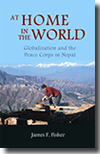| Our Publications | ||
| Books by Title | ||
| Books by Author | ||
| Books by Country | ||
| E-books | ||
| About | ||
| Orchid Press E-books | ||
| Distributed E-books | ||
| Our Bookshop | ||
| About Us | ||
| Browse Shop | ||
| How to Buy | ||
| Contact Us | ||
| WE BUY BOOKS AND LIBRARIES | ||
|
||
Book Reviews

At Home in the World:
Globalization and the Peace Corps in Nepal
byJames F. Fisher
2013, 218 pp., 21 b & w illustrations, endnotes, bibliography, index, 22 x 14 cm., softcover.
ISBN-13: 978-974-524-157-2 $25.00
At Home in the World:
Book review by Don Messerschmidt (Nepal 1963-65)
(http://peacecorpsworldwide.org)
Looking back at the Peace Corps of a half century ago seems to have caught on recently, detailing and analyzing some of the earliest PCV experiences worldwide, if the number of recent books on the subject is any indication. Jim Fisher’s book, At Home in the World: Globalization and the Peace Corps in Nepal, joins such other accounts as Geraldine Kennedy’s The Liberia One Storybook: The First Peace Corps Volunteers to Liberia Tell Their Stories; George Gurney’s Guatemala One: A Journal of the First Peace Corps Project; Julian Weldon Martin’s Imagonna: Peace Corps Memories (from Nigeria in the early 1960s), and others.
The Preface to Fisher’s book about Nepal-1 (1962-64) begins with the arrival of the first volunteers in Kathmandu on September 24, 1962, landing with a bump and a roar on what was then known as Gaucher (’Cow Pasture’) Field (now Tribhuvan International Airport, named after King Tribhuvan Bir Bikram Shah, 1906-55). Fisher describes his fellow PCVs as a small group of young Americans, mostly in their early 20s, touching down in a prop-driven DC-3 after flying up “from the fusty atmosphere of Delhi, down on the plains of India, up into the fresh mountain breezes wafting down from the Himalayas towering above the city.”
“Wanting to make a good first impression,” he goes on, some were dressed up in jackets and ties—“apparel they would not don again while in Nepal.” In a sense, the arrival formalities marked the first day of the rest of their lives which led, for most of them, through some remarkable worldview-changing experiences, both personal and professional.
Fisher’s book is not memoir in the traditional sense. Nor is it a book about globalization, per se. Rather, in his words, “it consists mostly of the stories and the histories of a few real, named people living in real time in real space with real Nepalis. It asks why these volunteers applied to the Peace Corps in the first place, how they were trained, what they wanted to do in Nepal and what they did there (not always the same thing), and what happened to them, and to Nepal and to America, in the 50 years since their arrival that halcyon September day.”
It is a tour de force of PC experiences and personal revelations told in a series of first-person accounts about what happened to many of the Nepal-1 volunteers, detailing how their lives were impacted by Nepal and how the volunteer experience ultimately impacted Nepal and America through the volunteers’ lives and, for some, their lifelong professional commitments. Many of those subsequent commitments and pursuits were clearly molded by the early Nepal experience.
James Fisher went on to become an anthropologist and taught at Carleton College for over three decades. His anthropological viewpoint is very clear in this sometimes intimate description of the early Peace Corps in Nepal. It details, in his words, “how the identities of individual Volunteers were challenged, forged, and altered by their experience,” and how they relate to what he calls “the seismic changes American society began to experience in politics, gender, race and profession” from the 1960s onward.
Fisher uses the concept of globalization to frame the many volunteer stories. He is at pains, however, to point out that the book “is not primarily about globalization.” Rather, it attempts to tell, often in their own words, how numerous PCV and other American and Nepali lives “were transformed and informed by the on-going globalization of which they were inexorably, if unwittingly, a part.” The book is a history only in the sense of revealing some of the intriguing personal stories of volunteers interacting with the Nepalese and, having been deeply affected by that experience, with their own countrymen and the world since.
This easily accessible book is both personally revealingly and scholarly in its description and analyses of some of the most profound impacts collected by the author from his PCV colleagues over a period of five decades. In a word, Fisher’s At Home in the World is a well composed, powerful, insightful, and highly recommended read.
The book has eight chapters, two Appendices, Endnotes, Bibliography and Index. And among the over 20 b&w photos is one of Sargent Shriver on his historic visit to Nepal in January 1964, as he deplaned from one of those (then) ubiquitous DC-3s by which many of us from those early days arrived in the alluring Asian mountain fastness of Nepal.
[Read a review from the Asian Highland Perspective] [Read a review from the Friends of Nepal] [Read a review from the The Kathmandu Post] [More Orchid Press Reviews]
PO Box 70, Trinity TB, NL, A0C 2S0, Canada
Telephone: +1 709-330-4703